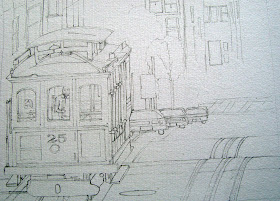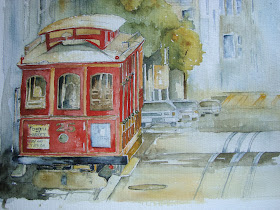Terrible rain and plenty of wind sent me scurrying back indoors, after being hopeful that I could do a little tidying up in the garden. Before the rain got too heavy, I took the opportunity to pick a few flower heads from one of my favourite plants in the garden. I have this ever-increasing clump of pale pink double Anemone Japonica. It is a beautiful sight at this time of year, and it was just what I needed to wet my appetite for a spot of painting. I only cut 4 blooms as I had no intention of painting a figurative still life with vase etc. I just wanted a reminder of how they are formed and the colour range in the petals. I did put them in a small pot, but simply to keep them fresh whilst I did the initial drawing.
I decided to use the 'Leonardo' paper as this was to be, for me, quite a large painting. I cut a full sheet in half, giving me a sheet 56cm x38cm
I completed the drawing, trying to get a variety of shapes and viewpoints, and included a couple of back views, hopefully to make the composition seem more natural. It was then just a question of painting the petals, trying to get depth and movement, and I used mainly Quinachridone Magenta with a little Opera Pink, to which I added a tiny amount of Quinachridone Purple if I needed some darker passages.
At this stage I was not sure how I was going to tackle the background, so I was careful to only paint right up to the pencil line and not over it. That way I was able to rub out the pencil once the paint was dry. This has the added advantage, where the paint has not gone right to the tips of the petals, deliberately leaving white paper for the highlights, the removal of the pencil lines gave me lost edged which I want to include in the painting.
This may be a good time to explain my trials and tribulations with 'Leonardo' paper. It was acquired, if you remember, to prevent buckling when using lots of water without having to stretch the paper.
When I first used it, I was so disappointed that I did consider giving it away as I thought I would never enjoy using it. However, with a little perseverance and a bit more pre-painting thought, I have managed to produce one or two reasonable paintings on it. (See Verbascum in 'As Different As Chalk And Cheese' and Blackberries in More Daniel Smith Colours' ). The following comments are only my thoughts and I am not claiming that there is anything technical wrong with the paper, and some wonderful artists use it all the time.
The paper is so thick it resembles blotting paper, hence :
1.It is very absorbent and takes quite a lot of wetting.
2.The paint tends to be instantly absorbed into the paper and is thus difficult to push around. It does not seem to have any surface which holds the paint until you have got it where you want it. This meant that I ended up with strong patches of paint, brush shaped which I could not dissipate.
3. Because of its absorbency, it takes much longer to dry. Having painted a petal, say, I waited for the surface to dry, before painting the adjacent petal, but after a few seconds, the water in the core of the paper made the two colours bleed into each other. You can see this in the stems of the Anemones. I will adapt them before mounting, but left them to illustrate my point.It does take ages to dry right through!
4. It does absorb lots of paint. With some of my colours at over £10 a shot, this can be a disadvantage.
Having said all that, it does stay flat, which is great, and I have been very pleased with the diffused effect, soft edges and muted colours which I have achieved on it.
I will keep using it, and you never know, I may be singing its praises before the end of the year!!
Back to the painting.
Having painted all the petals, it was time to make a decision about the background. I chose a mixture of all the colours in the petals and added Phalo Blue, Phalo Green and Cobalt Teal Blue in the main. Initially, I wet large areas of the background and dropped in some Quinachridone Magenta to give me some pale pink patches, and then when these were dry I re-wet the areas and dropped in other colours to produce dark and light passages. All that was left to do were the orange stamens, some shadows on the left hand side of the blooms, a little white gouache on some of the petal edges and a bit of judicious splattering with the white gouache.
I am quite pleased with the finished result. It is quite a bit tighter than some of my recent paintings, but that's ok as it makes for a varied and interesting exhibition. I am especially pleased with the top left background!
Hope you have enjoyed looking.


















